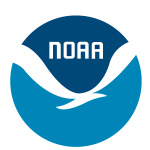- Industrie: Government
- Number of terms: 30456
- Number of blossaries: 0
- Company Profile:
NOAA Coral Reef Conservation Program, National Oceanic and Atmospheric Administration, U.S. Department of Commerce
As part of the National Environmental Policy Act (NEPA) process, an EIS is an analysis of the expected impacts resulting from a proposed Federal action (such as fisheries management or a development plan) on the environment. An EIS is required for all fishery management plans as well as significant amendments to existing plans. The purpose of an EIS is to ensure that the proposed Federal action gives appropriate consideration to environmental values in order to prevent harm to the environment.
Industry:Fishing
A gillnet fixed to the bottom, or at a certain distance above it, by means of anchors or ballast sufficiently heavy to neutralize the buoyancy of the floats.
Industry:Fishing
1. An overfished stock or stock complex "whose size is sufficiently small that a change in management practices is required to achieve an appropriate level and rate of rebuilding". A stock or stock complex is considered overfished when its population size falls below the minimum stock size threshold (MSST). A rebuilding plan is required for stocks that are deemed overfished; 2. A stock is considered "overfished" when exploited beyond an explicit limit beyond which its abundance is considered 'too low' to ensure safe reproduction. In many fisheries the term is used when biomass has been estimated to be below a limit biological reference point that is used as the signpost defining an "overfished condition". This signpost is often taken as being FMSY, but the usage of the term may not always be consistent.
Industry:Fishing
1. The ability of a stock of inputs (capital) to produce output (measured as either effort or catch); 2. The maximum amount of fish over a period of time (year, season) that can be produced by a vessel or fleet of vessels if fully utilized, given the biomass and age structure of the fish stock and the present state of the technology. The "fishing fleet" is the stock of inputs (i.e. physical capital and human capital). The term "fully utilized" is used in a precautionary context in that it assumes that capacity utilization is 100 percent; 3. The quantity of fish that can be taken by a fishing unit, for example an individual, community, vessel, or fleet, assuming that there is no limitation on the yield from the stock, usually expressed in terms of some measure of vessel size, such as gross tonnage, hold capacity, horsepower. Reflects potential rather than nominal fishing effort.
Industry:Fishing
As part of the National Environmental Policy Act (NEPA) process, an EA is a concise public document that provides evidence and analysis for determining whether to prepare an environmental impact statement (EIS) or a finding of no significant impact (FONSI).
Industry:Fishing
1. A reference point indicates a particular state of a fishery indicator corresponding to a situation considered as desirable (target reference point) or undesirable and requiring immediate action (limit reference point and threshold reference point); 2. An estimated value derived from an agreed scientific procedure and/or model, which corresponds to a specific state of the resource and of the fishery, and that can be used as a guide for fisheries management. Reference points may be general (applicable to many stocks) or stock-specific; 3. Values of parameters (e.g. BMSY, FMSY, F0. 1) that are useful benchmarks for guiding management decisions. Biological reference points are typically limits that should not be exceeded with significant probability (e.g. MSST) or targets for management (e.g. OY).
Industry:Fishing
An EFH assessment is a written assessment of the effects of a proposed Federal action on EFH. Federal agencies must provide the National Marine Fisheries Service (NMFS) with an EFH assessment for any action that may adversely affect EFH, except for those activities covered by a general concurrence. An EFH assessment must contain 1) a description of the proposed action; 2) an analysis of the effects, including cumulative effects, of the proposed action on EFH and managed species; 3) the Federal agency's conclusions regarding the effects of the action on EFH; and 4) proposed mitigation, if applicable. If appropriate, the EFH assessment should also include the items listed at 50 CFR 600. 920(e)(4). The level of detail in an EFH assessment should be commensurate with the potential impacts to EFH.
Industry:Fishing
1. A deterministic process or model does not take account or include any stochastic (random) variability. The opposite is a stochastic model; 2. A model whose behavior is fully specified by its form and parameters, unlike a stochastic model.
Industry:Fishing
